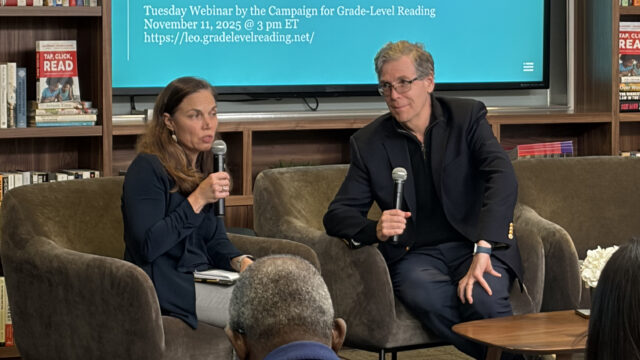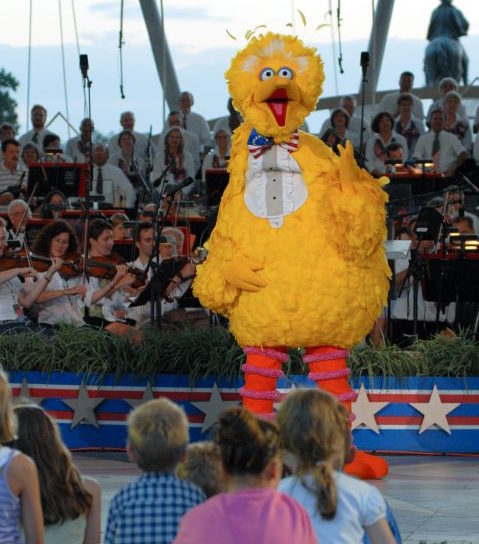
Over the past several years, New America and the Joan Ganz Cooney Center at Sesame Workshop have become known for our book Tap, Click, Read and for our joint research and analysis on how digital technologies could be used to improve, instead of impede, early literacy. Now our two organizations are going a step further: This month we are releasing a toolkit of materials designed to help educators and other leaders put these insights into practice to help children learn to read. Fourteen research-based resources—including tipsheets, discussion guides, ratings lists, and a quiz—are now downloadable and free for further distribution at TapClickRead.org/Take-Action.
To reach large audiences of educators and community leaders, we have formed partnerships with FirstBook and the Campaign for Grade Level Reading, two organizations that are dedicated to closing literacy divides and ensuring that children in low-income families and high-need schools have access to high-quality teaching and reading materials. We will also be actively promoting these materials in the coming months through Media Literacy Week (Oct 31-Nov 4) and at the annual meeting of the National Association for the Education of Young Children in Los Angeles in a featured session on November 3.
With the creation and release of these materials, we are trying to “walk the talk.” We recognize that in today’s high-paced world, adults as well as children are learning in multiple ways, and they need easy access to multimedia materials that spark conversation and new ideas. Since the book’s release in October 2015, we have been providing information in as many formats as possible: through the stories and brilliant people we introduce in the chapters of our book, through presentations we have given around the country, through five videos that are freely available on our site, on YouTube, and on Vimeo; through social media conversations at #TapClickRead on Twitter and throughout Facebook; through one-and-two page downloadables (including ratings charts, quizzes, and expert advice); and through discussion guides that are designed to prompt critical thinking by educators and other leaders throughout communities.
Our book and the accompanying resources lay out a vision for building 21st century ecosystems of learning that combine the best of media and reading. We playfully call this combination “Readialand.” We believe that Readialand ecosystems can be created in communities around the country through new collaborations between educators, families, and community leaders who recognize that 21st-century learning has to be human-powered first and tech-assisted second.
- What Educators Can Do—A list of recommendations for updating teaching methods, working with libraries and public media, and more.
- What Parents Can Do—A list of ideas for parents and caregivers, including the importance of listening to and talking with children about the media they use and why.
- How to Use Media to Support Children’s Home Language—Used well, media can spark opportunities for children to converse with their family members at home in their native languages. This helps them build a foundation for learning English too.
- How to Promote Creation and Authorship—Children need to learn what it means to be a creator, not just a consumer, of media. New tools bring this concept to life.
- How to Find Apps for Literacy Learning—Choose wisely. Use app-review sites and advice from literacy experts to find materials that match your students’ needs.
- The Three C’s—Content, context, and the individual child. Become more mindful in using digital technology with young children by taking this quiz.
- A Modern Action Plan for States and Communities—A guide for community and state leaders on how to make progress in solving America’s reading crisis and strengthening family-centered approaches that will endure over time.
- 12 Actions to Take Now—A one-page list of “must-dos” for community leaders, district administrators, and policymakers to break out of the literacy crisis and bring opportunities to all children.
- What Developers Can Do—Media and technology developers can become a key part of creating ecosystems of learning by partnering with educators and recognizing the needs of today’s diverse families.
We have also produced five discussion guides to accompany short videos that could be used to spark dialogue in community workshops or professional learning community meetings:
Comienza en Casa: Helping immigrant families prepare their children for kindergarten.
- Video vignette (5:15 minutes)
- Discussion guide
Tutormate: Matching community volunteers with first-grade students for weekly reading sessions.
- Video vignette (4:18 minutes)
- Discussion guide
Parents And Children Together (PACT): Encouraging parents to read with their children using e-books and text messages.
- Video vignette (5:05 minutes)
- Discussion guide
Play and Learning Strategies (PALS): Helping parents see how to create language-rich moments with their children.
- Video vignette (5:37 minutes)
- Discussion guide
Univision and Too Small to Fail: Spreading messages about the importance of talking, singing, and reading with young children.
- Video vignette (4:06 minutes)
- Discussion guide
Funding from the Pritzker Children’s Initiative made it possible for us to do the lion’s share of writing and researching the book, producing the videos, and creating and distributing the toolkit comprised of these 9 downloadable resources and 5 discussion guides. The idea for this project was sparked by the Campaign for Grade-Level Reading. We are grateful to the Pritzker Children’s Initiative and CGLR for their support. All royalties from sales of Tap, Click, Read are invested back into the education research programs at our two institutions, New America and the Joan Ganz Cooney Center at Sesame Workshop, and all materials on the TapClickRead.org website are openly licensed under the Creative Commons CC BY 4.0 license.
Buy the book now on Amazon.com.




